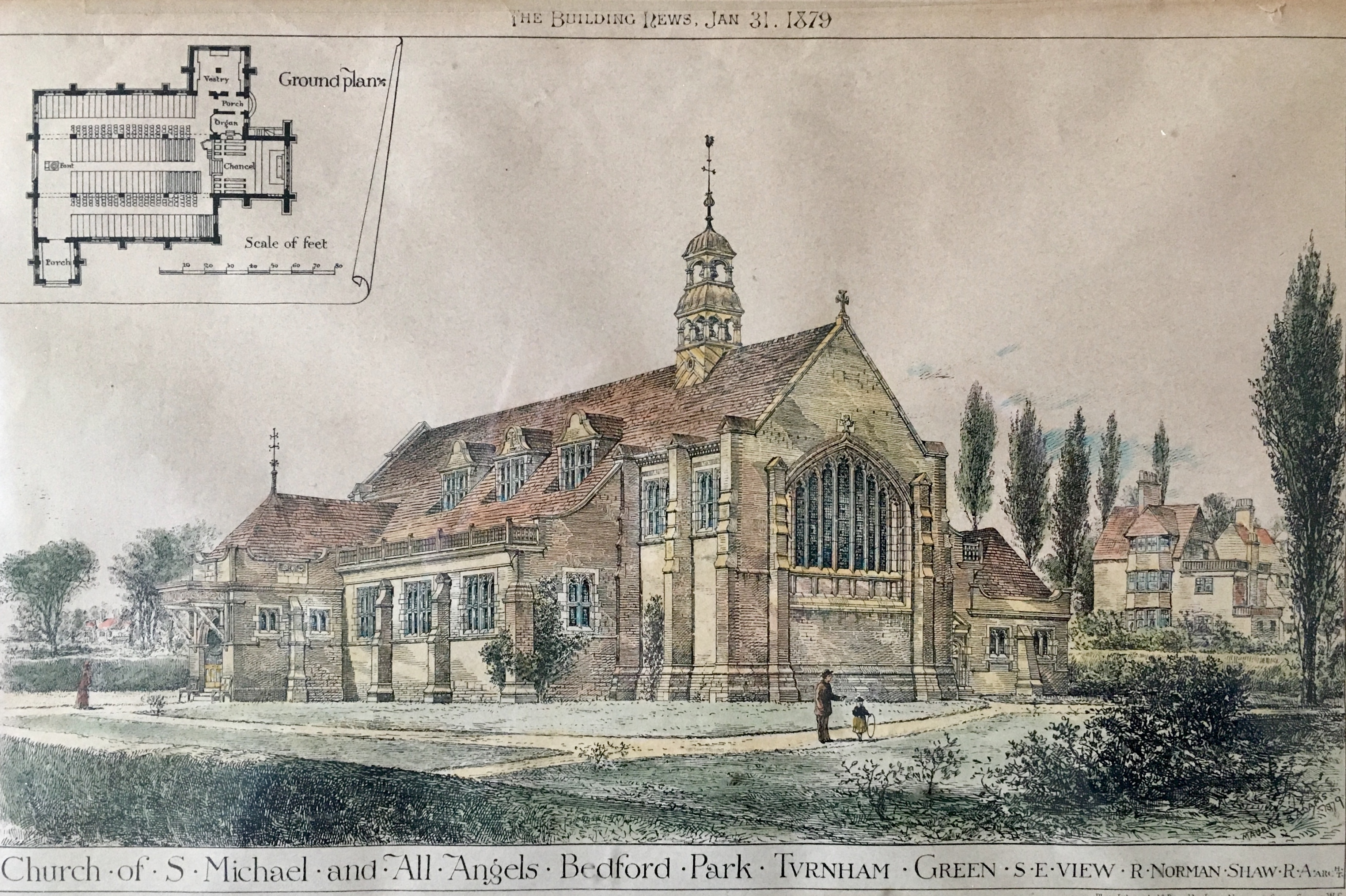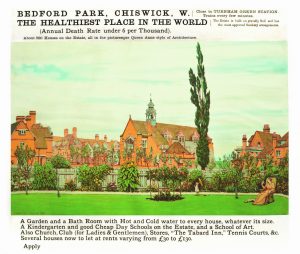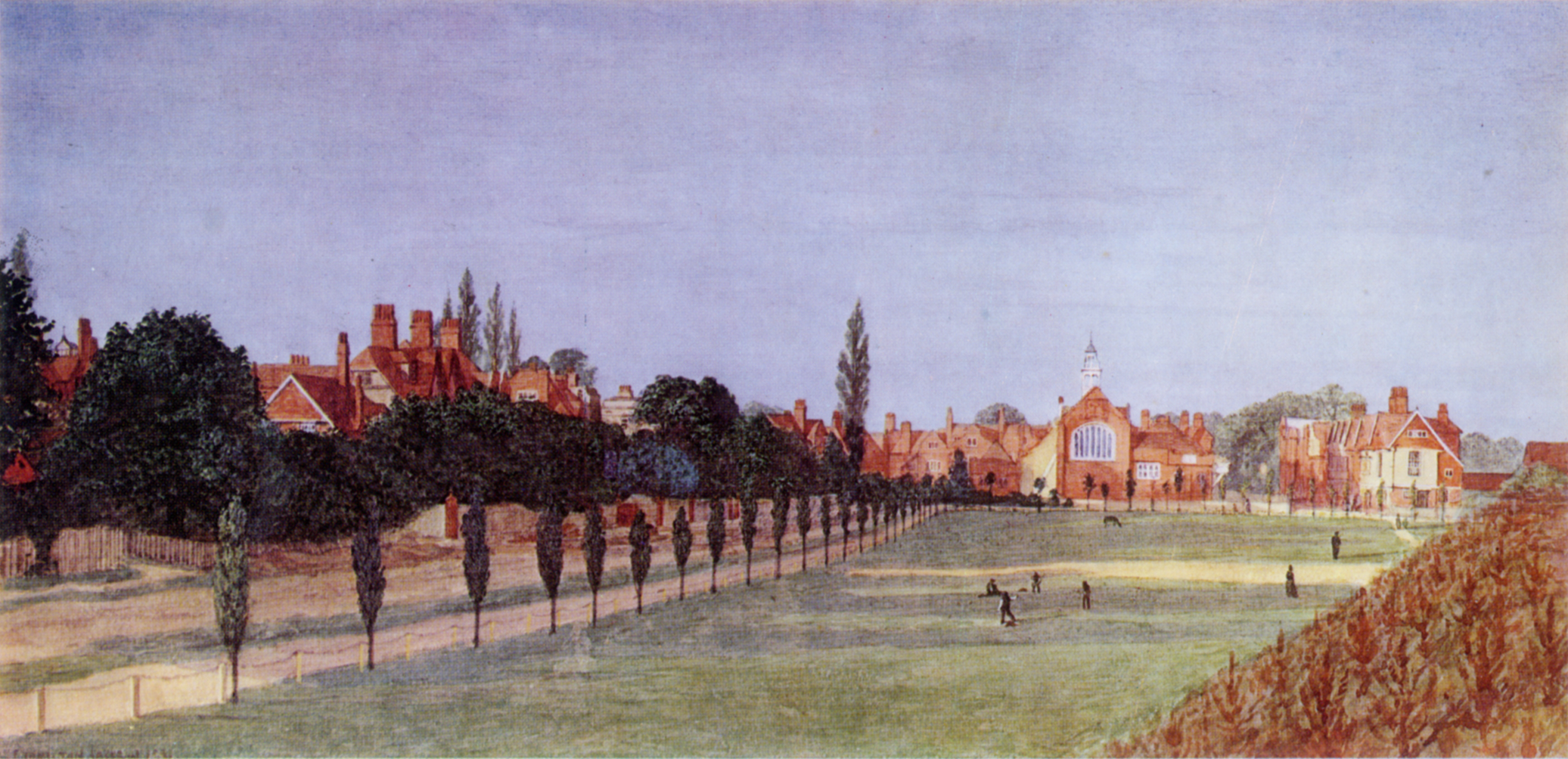
This watercolour – St Michael & All Angels Bedford Park 1881 – is by F Hamilton Jackson, once principal of the Bedford Park School of Art and one of the first two churchwardens at St Michael’s. It was given to the Bedford Park Society by two local residents, Andrew and Hanna Alers Hankey. The Society has kindly given permission for it to be shown here. Membership of the Society costs £15 for a household (two people), £10 for a single. Cheques to the Membership Secretary, the Bedford Park Society, 68 Esmond Road, W4 1JF; or you can join at the Society’s Green Days stall in June, when committee members are on hand to answer any questions.
140 Years Serving Christ in the Community
St Michael & All Angels recently celebrated 140 years serving Christ in the community – twice the ‘three score years and ten’ which are ‘the days of our years’, according to the King James Bible. On January 31st 1879, the line drawing below, showing Richard Norman Shaw’s design for the church, appeared in Building News. It was drawn by the publication’s editor, Maurice Adams, one of the main architects of Bedford Park and the other churchwarden at St Michael & All Angels when it opened, alongside F Hamilton Jackson. The present church’s foundation stone was laid on May 31st, 1879 and the building was consecrated by the Bishop of London the following year, on April 17th 1880.
You can read more about the history of St Michael & All Angels, and see more pictures, on St Michael’s World War 1 Project website, the Victorian Web website and the Bedford Park page of this website.
A brief history of the Church*
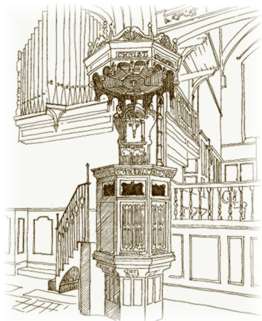 The first St Michael & All Angels church was a temporary iron structure in a market garden on Chiswick High Road, facing the top of Chiswick Lane. Inaugurated in 1876, its first incumbent, Reverend Alfred Wilson, soon started fund-raising for a permanent church. The present church’s foundation stone was laid on May 31st, 1879 and the building was consecrated by the Bishop of London the following year, on April 17th 1880. However, controversy had developed over the nature of St Michael’s services.
The first St Michael & All Angels church was a temporary iron structure in a market garden on Chiswick High Road, facing the top of Chiswick Lane. Inaugurated in 1876, its first incumbent, Reverend Alfred Wilson, soon started fund-raising for a permanent church. The present church’s foundation stone was laid on May 31st, 1879 and the building was consecrated by the Bishop of London the following year, on April 17th 1880. However, controversy had developed over the nature of St Michael’s services.
On the day of its consecration, a letter addressed to the Bishop of London was printed in the Acton, Chiswick & Turnham Green Gazette, accusing Reverend Wilson of “Popish and Pagan mummeries”. Signed by Henry Smith, churchwarden of Chiswick, it listed his supposed transgressions: marching in procession round the church, prostrating himself before the consecrated elements, making the sign of the cross when giving the elements to the people and singing the Agnus Dei. The controversy raged for months in the paper, which sent its own reporter who observed that the service was very “high” and reminiscent of a Roman Catholic Church.
From these foundations, the worshipping tradition of St Michael & All Angels has remained Anglo-Catholic. St Michael & All Angels was designed by the influential Victorian architect, Norman Shaw. He is best known for the old New Scotland Yard building on Victoria Embankment, the Royal Geographical Society in Kensington and many country houses, including Cragside, a National Trust property in Northumberland. Shaw’s biographer, the architectural historian Andrew Saint, says St Michael’s has “probably the best-preserved Norman Shaw interior in London”.
Shaw succeeded E.W.Godwin as Estate Architect for Bedford Park and also designed several of its first houses, in a distinctive “Queen Anne Revival” style, using red brick and white joinery. St Michael’s was intended to reflect that style. It has been described by architects as “theatrical”, “a mongrel mixing of Gothic and Queen Anne”, “very novel and not very ecclesiastical”, and “a bold and perceptive character study of a community”.
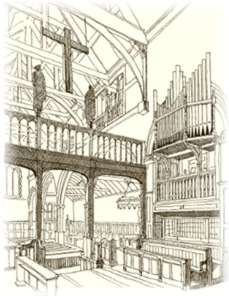 Sir John Betjeman, the Poet Laureate and architectural writer, described St Michael’s as “a very lovely church and a fine example of Norman Shaw’s work.” He recalled that Shaw had written of its design, in a letter to an architect friend: “I’m a house man – not a church man – and soil pipes are my speciality.”
Sir John Betjeman, the Poet Laureate and architectural writer, described St Michael’s as “a very lovely church and a fine example of Norman Shaw’s work.” He recalled that Shaw had written of its design, in a letter to an architect friend: “I’m a house man – not a church man – and soil pipes are my speciality.”
The Parish Hall (or Parish Room, as it was originally called) and the adjoining north aisle were added later. The Parish Hall was designed in the year 1884 (as was the font, completed that year) by another Bedford Park architect Maurice B. Adams, St. Michael & All Angels’ first churchwarden. It was completed in 1887. The north aisle (including the current pulpit and the choir stalls) was completed and consecrated in 1892.
A fund was set up to raise money for the Parish Room, through events such as a three-day “Garden Fete and Fancy Fayre” in June 1886, under the patronage of HRH The Princess Mary Adelaide, Duchess of Teck. This idea was revived in 1967, as the Bedford Park Festival, and the event – now lasting two weeks – has been held every June since, to raise money for local charities and the maintenance of the church buildings.
St Michael’s was listed as a historic building in 1951, but until the 1960s, St Michael’s had seen few repairs. During the Second World War, the roof – as well as most of the stained glass – had been badly damaged by a bomb that destroyed Chiswick Polytechnic. The stained glass in the East Window was replaced in 1952 to a design by Lawrence Lee – but other repair work had been haphazard. Since the mid-60s, there has been regular renovation – repainting in 1969, central heating in 1975, major restoration of the external fabric and new roofing in 1980.
In 1989, when the church needed rewiring and new lighting, some of the thousands of pounds needed was raised by each of the professions in Bedford Park sponsoring one of the chandeliers, which form the principal lighting in the church. Much of the remainder came from an unusual source – a film company. St Michael & All Angels was the setting for Nuns on the Run, a comedy in which Eric Idle and Robbie Coltrane played two crooks, who dress up as nuns and hide in a convent.
In 2001, St Michael & All Angels Parish Hall was reopened, after a £500,000 regeneration project, which rebuilt the Victorian hall as a new community centre for the whole of Bedford Park. The capacity of the building was doubled by adding an extra floor, providing three halls. See History of the Parish Hall.
Sketches by Oliver West
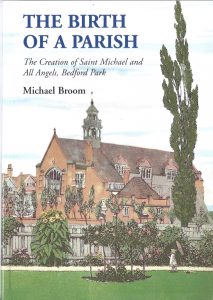 * A much fuller account of the early days can be found in a book, The Birth of A Parish – The Creation of St Michael & All Angels, Bedford Park, by the late Michael Broom. Copies can be bought from the Parish Office, price £9.99.
* A much fuller account of the early days can be found in a book, The Birth of A Parish – The Creation of St Michael & All Angels, Bedford Park, by the late Michael Broom. Copies can be bought from the Parish Office, price £9.99.
The best-known image of St Michael & All Angels is shown below. It was used to promote the new estate of Bedford Park in its early days as “the healthiest place in the world”, and in 2018-2019 was displayed in an exhibition at the Wellcome Collection alongside other images of the first garden suburb. The free exhibition – ‘Living with Buildings’ – examined the impact of architecture on our health and wellbeing. It is also featured on the Chiswick Timeline: A History in Art and Maps, the mural underneath the bridges at Turnham Green station.
